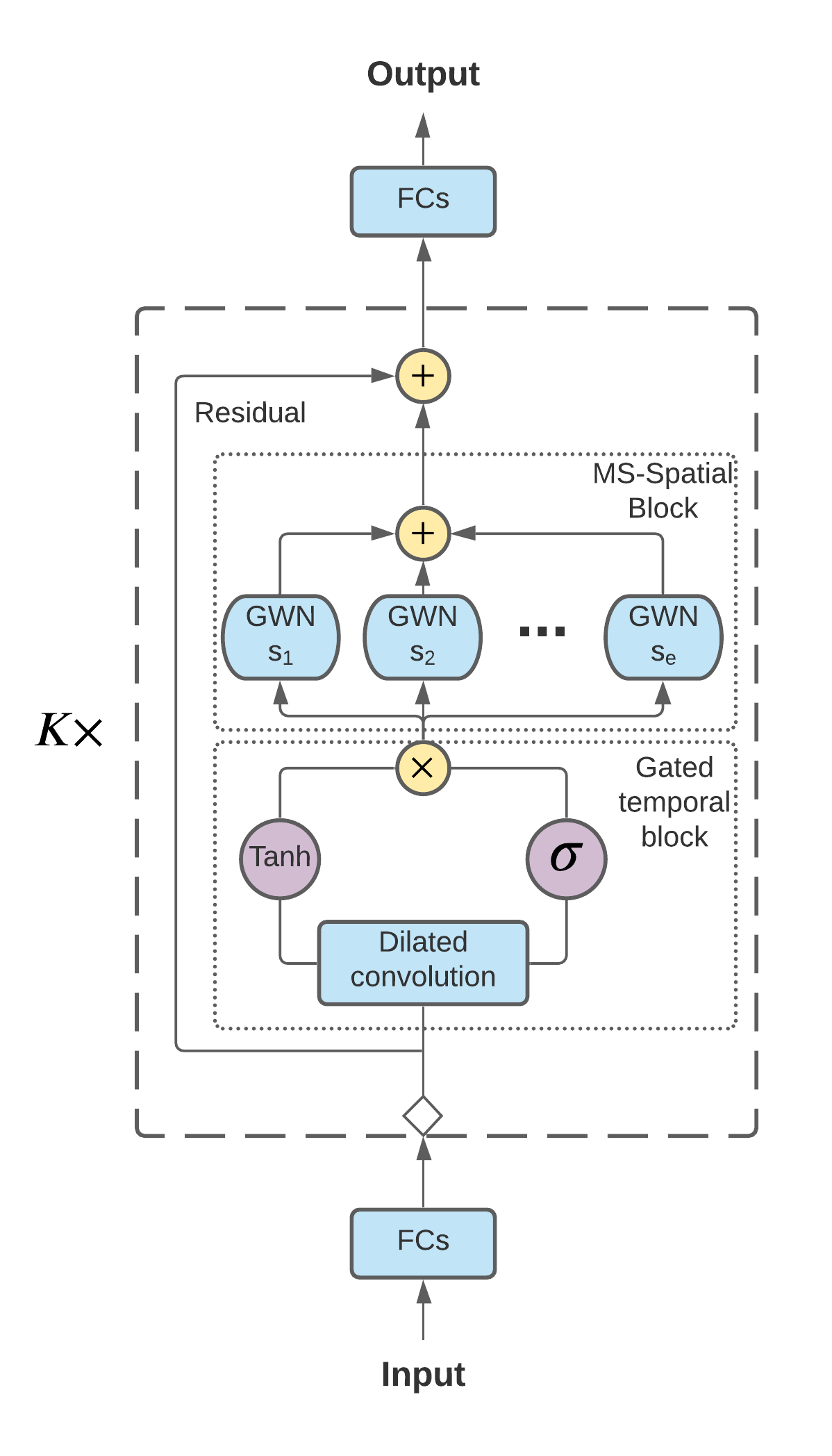SAMSGL: Series-Aligned Multi-Scale Graph Learning for Spatio-Temporal Forecasting

0
📊
Sign in to get full access
Overview
- This paper presents a Series-Aligned Multi-Scale Graph Learning (SAMSGL) framework for improving the performance of spatio-temporal forecasting tasks, such as traffic prediction and weather forecasting.
- The key innovations are a series-aligned graph convolution layer to handle time delays in spatial interactions, and a multi-scale graph learning architecture to capture both global and local spatio-temporal interactions.
- The authors evaluate the effectiveness of SAMSGL on meteorological and traffic forecasting datasets, demonstrating its superiority over existing approaches.
Plain English Explanation
The paper tackles the challenge of spatio-temporal forecasting, which involves predicting future values in datasets that have both spatial (location) and temporal (time) dimensions, such as traffic patterns or weather forecasts.
The key difficulties in this task are modeling the propagation of information over time and space, and capturing the complex interactions between different locations. While graph-based neural networks have shown promise in this area, the authors identify two important factors that need further consideration: time delays in how information spreads, and the need to understand both global and local spatio-temporal patterns.
To address these challenges, the researchers developed the SAMSGL framework, which has two main components:
-
Series-Aligned Graph Convolution: This layer helps the model account for time delays in how information propagates across the graph, by aligning the graph signals in time before aggregating them.
-
Multi-Scale Graph Learning: This architecture learns both global and local spatio-temporal interactions. The global graph structure captures delayed and non-delayed node embeddings, while the local graph structure learns how neighboring factors influence a node's variations over time.
By incorporating these innovations, the SAMSGL framework is able to outperform existing approaches on traffic and weather forecasting tasks.
Technical Explanation
The key technical elements of the SAMSGL framework are:
-
Series-Aligned Graph Convolution Layer: To handle time delays in spatial interactions, the authors propose a series-aligned graph convolution layer. This layer aggregates non-delayed graph signals, mitigating the influence of time delays and improving forecasting accuracy.
-
Multi-Scale Graph Learning Architecture: This architecture consists of two main components:
- Multi-Scale Graph Structure Learning: This includes a global graph structure to learn both delayed and non-delayed node embeddings, as well as a local graph structure to capture node variations influenced by neighboring factors.
- Graph-FC Blocks: These blocks synergistically fuse spatial and temporal information to boost prediction accuracy.
The authors evaluate the SAMSGL framework on meteorological and traffic forecasting datasets. Their experiments demonstrate the effectiveness and superiority of their approach compared to existing methods.
Critical Analysis
The paper presents a well-designed solution to the challenges of spatio-temporal forecasting. The series-aligned graph convolution layer and the multi-scale graph learning architecture are both novel and well-justified by the authors.
One potential limitation is the computational complexity of the multi-scale graph learning approach, which may limit its scalability to very large-scale problems. The authors do not provide a detailed analysis of the runtime or memory requirements of their framework.
Additionally, the paper does not address the interpretability of the learned graph structures and how they relate to the underlying physical processes governing the spatio-temporal dynamics. Further research could explore methods to extract meaningful insights from the learned graph representations.
Overall, the SAMSGL framework represents a significant advancement in the field of spatio-temporal forecasting, and the authors' rigorous experimental evaluation lends strong support to the effectiveness of their approach.
Conclusion
This paper introduces the Series-Aligned Multi-Scale Graph Learning (SAMSGL) framework, which addresses two key challenges in spatio-temporal forecasting: modeling time delays in propagation dynamics and capturing multi-scale high-dimensional interactions. By incorporating a series-aligned graph convolution layer and a multi-scale graph learning architecture, the SAMSGL framework demonstrates superior performance on meteorological and traffic forecasting tasks compared to existing methods.
The innovations presented in this work have the potential to drive further progress in spatio-temporal forecasting, with applications across a wide range of domains, from urban planning and transportation to climate modeling and environmental monitoring. As the field continues to evolve, the principles and techniques developed in this research could serve as a foundation for even more advanced spatio-temporal forecasting models and systems.
This summary was produced with help from an AI and may contain inaccuracies - check out the links to read the original source documents!
Related Papers
📊

0
SAMSGL: Series-Aligned Multi-Scale Graph Learning for Spatio-Temporal Forecasting
Xiaobei Zou, Luolin Xiong, Yang Tang, Jurgen Kurths
Spatio-temporal forecasting in various domains, like traffic prediction and weather forecasting, is a challenging endeavor, primarily due to the difficulties in modeling propagation dynamics and capturing high-dimensional interactions among nodes. Despite the significant strides made by graph-based networks in spatio-temporal forecasting, there remain two pivotal factors closely related to forecasting performance that need further consideration: time delays in propagation dynamics and multi-scale high-dimensional interactions. In this work, we present a Series-Aligned Multi-Scale Graph Learning (SAMSGL) framework, aiming to enhance forecasting performance. In order to handle time delays in spatial interactions, we propose a series-aligned graph convolution layer to facilitate the aggregation of non-delayed graph signals, thereby mitigating the influence of time delays for the improvement in accuracy. To understand global and local spatio-temporal interactions, we develop a spatio-temporal architecture via multi-scale graph learning, which encompasses two essential components: multi-scale graph structure learning and graph-fully connected (Graph-FC) blocks. The multi-scale graph structure learning includes a global graph structure to learn both delayed and non-delayed node embeddings, as well as a local one to learn node variations influenced by neighboring factors. The Graph-FC blocks synergistically fuse spatial and temporal information to boost prediction accuracy. To evaluate the performance of SAMSGL, we conduct experiments on meteorological and traffic forecasting datasets, which demonstrate its effectiveness and superiority.
Read more5/29/2024


0
SAGDFN: A Scalable Adaptive Graph Diffusion Forecasting Network for Multivariate Time Series Forecasting
Yue Jiang, Xiucheng Li, Yile Chen, Shuai Liu, Weilong Kong, Antonis F. Lentzakis, Gao Cong
Time series forecasting is essential for our daily activities and precise modeling of the complex correlations and shared patterns among multiple time series is essential for improving forecasting performance. Spatial-Temporal Graph Neural Networks (STGNNs) are widely used in multivariate time series forecasting tasks and have achieved promising performance on multiple real-world datasets for their ability to model the underlying complex spatial and temporal dependencies. However, existing studies have mainly focused on datasets comprising only a few hundred sensors due to the heavy computational cost and memory cost of spatial-temporal GNNs. When applied to larger datasets, these methods fail to capture the underlying complex spatial dependencies and exhibit limited scalability and performance. To this end, we present a Scalable Adaptive Graph Diffusion Forecasting Network (SAGDFN) to capture complex spatial-temporal correlation for large-scale multivariate time series and thereby, leading to exceptional performance in multivariate time series forecasting tasks. The proposed SAGDFN is scalable to datasets of thousands of nodes without the need of prior knowledge of spatial correlation. Extensive experiments demonstrate that SAGDFN achieves comparable performance with state-of-the-art baselines on one real-world dataset of 207 nodes and outperforms all state-of-the-art baselines by a significant margin on three real-world datasets of 2000 nodes.
Read more6/19/2024


0
Traffic Prediction considering Multiple Levels of Spatial-temporal Information: A Multi-scale Graph Wavelet-based Approach
Zilin Bian, Jingqin Gao, Kaan Ozbay, Zhenning Li
Although traffic prediction has been receiving considerable attention with a number of successes in the context of intelligent transportation systems, the prediction of traffic states over a complex transportation network that contains different road types has remained a challenge. This study proposes a multi-scale graph wavelet temporal convolution network (MSGWTCN) to predict the traffic states in complex transportation networks. Specifically, a multi-scale spatial block is designed to simultaneously capture the spatial information at different levels, and the gated temporal convolution network is employed to extract the temporal dependencies of the data. The model jointly learns to mount multiple levels of the spatial interactions by stacking graph wavelets with different scales. Two real-world datasets are used in this study to investigate the model performance, including a highway network in Seattle and a dense road network of Manhattan in New York City. Experiment results show that the proposed model outperforms other baseline models. Furthermore, different scales of graph wavelets are found to be effective in extracting local, intermediate and global information at the same time and thus enable the model to learn a complex transportation network topology with various types of road segments. By carefully customizing the scales of wavelets, the model is able to improve the prediction performance and better adapt to different network configurations.
Read more6/21/2024


0
SMA-Hyper: Spatiotemporal Multi-View Fusion Hypergraph Learning for Traffic Accident Prediction
Xiaowei Gao, James Haworth, Ilya Ilyankou, Xianghui Zhang, Tao Cheng, Stephen Law, Huanfa Chen
Predicting traffic accidents is the key to sustainable city management, which requires effective address of the dynamic and complex spatiotemporal characteristics of cities. Current data-driven models often struggle with data sparsity and typically overlook the integration of diverse urban data sources and the high-order dependencies within them. Additionally, they frequently rely on predefined topologies or weights, limiting their adaptability in spatiotemporal predictions. To address these issues, we introduce the Spatiotemporal Multiview Adaptive HyperGraph Learning (SMA-Hyper) model, a dynamic deep learning framework designed for traffic accident prediction. Building on previous research, this innovative model incorporates dual adaptive spatiotemporal graph learning mechanisms that enable high-order cross-regional learning through hypergraphs and dynamic adaptation to evolving urban data. It also utilises contrastive learning to enhance global and local data representations in sparse datasets and employs an advance attention mechanism to fuse multiple views of accident data and urban functional features, thereby enriching the contextual understanding of risk factors. Extensive testing on the London traffic accident dataset demonstrates that the SMA-Hyper model significantly outperforms baseline models across various temporal horizons and multistep outputs, affirming the effectiveness of its multiview fusion and adaptive learning strategies. The interpretability of the results further underscores its potential to improve urban traffic management and safety by leveraging complex spatiotemporal urban data, offering a scalable framework adaptable to diverse urban environments.
Read more7/26/2024